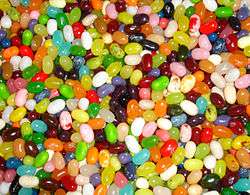Jelly bean
Jelly beans are small bean-shaped sugar candies with soft candy shells and thick gel interiors (see gelatin and jelly). The confection is primarily made of sugar and sold in a wide variety of colors and flavors.
 Jelly bean (Jelly Belly brand) flavor and color assortment | |
| Type | Confectionery |
|---|---|
| Place of origin | United States |
| Created by | William Schrafft |
History
It has been claimed that jelly beans were first mentioned during 1861, when Boston confectioner William Schrafft urged people to send his jelly beans to soldiers during the American Civil War. It was not until July 5, 1905, that jelly beans were mentioned in the Chicago Daily News. The advertisement publicized bulk jelly beans sold by volume for nine cents per pound, according to the book The Century in Food: America's Fads and Favorites. Most historians contend that jelly beans were first associated with celebrations of Easter in the United States sometime during the 1930s due to their egg-like shape.[1] With the invention of plastic Easter eggs, jelly beans could go inside.
Manufacture
The basic ingredients of jelly beans include sugar, tapioca or corn syrup, and pectin or starch. Relatively minor amounts of the emulsifying agent lecithin, anti-foaming agents, an edible wax such as carnauba wax or beeswax, salt, and confectioner's glaze are also included.[2] The ingredients that give each bean its character are also relatively small in proportion and may vary depending on the flavor.
Most jelly beans are sold as an assortment of about eight different flavors, most of them fruit-based. Assortments of "spiced" jellybeans and gumdrops are also available, which include a similar number of spice and mint flavors. The colors of jelly beans often correspond with a fruit and a "spiced" flavor.
Some premium brands, such as Jelly Belly and The Jelly Bean Factory, are available in many different flavors, including berry, tropical fruit, soft drink, popcorn, licorice, and novelty ranges, in addition to the familiar fruit and spice flavors. While these are also sold as assortments, individual flavors can be purchased from distributors.
Slang

In United States slang during the 1910s and early 1920s, a "Jellybean" or "Jelly-Bean" was a young man who dressed stylishly but had little else to recommend him, similar to the older terms dandy and fop. F. Scott Fitzgerald published a story about such a character, The Jelly-Bean, during 1920.[3] In William Faulkner's 1929 novel The Sound and the Fury, Jason complained about his niece Quentin's promiscuity, remarking that even "the town jellybeans" gave her the "go-by".
The song "Jelly Bean (He's a Curbstone Cutie)" was made popular during the 1940s by Phil Harris. It was written by Jimmie Dupre, Sam Rosen, and Joe Verges and published in New Orleans during 1920 by Universal Music Publishers, Inc.
Within the Mexican drug cartel, the word "Jelly-Bean" is often used as a code word for bullets and other small varieties of ammunition.
In popular culture
When Beatlemania broke out in 1963, fans of the Beatles in the US pelted the band with jelly beans (emulating fans in the UK who threw the British candy Jelly Babies at George Harrison, who reportedly liked eating them).[4][5][6]
See also
- Gummi bears
- Skittles (candy)
- Nerds (candy)
- Jelly babies
References
- "Jelly Beans: A Colorful History and Association with Easter". AT&T. Archived from the original on 2015-09-23. Retrieved 2011-05-10.
- "How Products are Made – Volumes – Jelly Beans". Gale-Edit. Archived from the original on 2010-05-16. Retrieved 2010-02-19.
- Francis Scott Fitzgerald, Matthew Joseph Bruccoli, Judith Baughman, "The Jelly-Bean", Before Gatsby: the first twenty-six stories, p. 341CS1 maint: multiple names: authors list (link)
- "Letter reveals The Beatles' fear of jelly baby fans". mirror. May 14, 2009.
- "George Harrison's 1963 plea: stop throwing jelly babies at Beatles" The Times 14 May 2009
- Perry, By Charles. "The secret life of jelly beans". latimes.com.
External links
